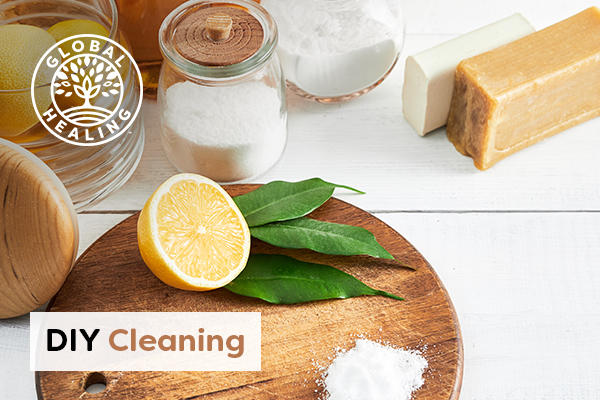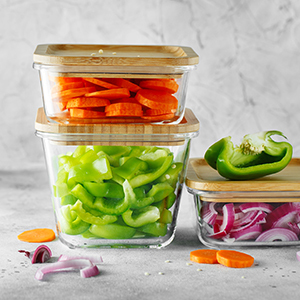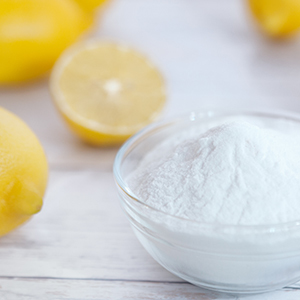
It’s cleaning day! Time to put on your favorite old jeans, sweatpants, or even pajamas. Crank up some loud music or just enjoy the silence. The unpleasant smells and harsh chemicals usually associated with cleaning are a thing of the past with these "Do it yourself" or DIY cleaning recipes.
Don’t dread giving the toilet bowl or kitchen floors a good scrubbing when you use all-natural homemade cleaning products. These recipes can make you feel great about cleaning toxin-free! These easy recipes can work for every room of your house.
From a daily surface cleaner to homemade laundry detergent, you can customize the scent of all of these DIY products using essential oils. You’ll avoid all the harmful chemicals and save money because they use just a few basic ingredients.
Benefits Of Using Natural Cleaning Products
For people with issues with their respiratory tract or lungs, like asthma, all-natural cleaning products — especially ones you make yourself — provide one of the best defenses for your health. Those with sensitive skin or eyes will notice the difference between natural cleaning products and harsh chemical cleaners.[1] And for all people, you will avoid additional exposure to toxic chemicals, which causes subtle and not-so-subtle health issues over time.
Also, there’s an environmental benefit: using green cleaning methods reduces harmful contaminants polluting the air and water. Reusable glass jars for DIY cleaning products can also eliminate plastic waste and reduce packaging.
Nature’s Best Cleaners: The Top Ingredients for DIY Recipes
Having these items on hand will keep you prepared for satisfying and safe house cleaning:
- Baking soda
- Castile soap
- Essential oils
- Hydrogen peroxide
- Lemons
- Rubbing alcohol (90 to 99% isopropyl)
- Washing soda
- White vinegar
DIY Eco-Friendly Recipes for Household Cleaning
These simple recipes for natural homemade cleaners are so effective,[2] you may never go back to store-bought products again! Choose organic ingredients wherever possible.
Window Cleaner & Surface Degreaser
This cleaner works great and is handy for quick daily cleanups of both windows and surfaces. Kitchen grease can be stubborn, but with a little muscle, these ingredients will do the trick.
Ingredients:
- ¼ cup rubbing alcohol (90 to 99% isopropyl)
- ¼ cup white vinegar
- 1 tablespoon cornstarch
- 2 cups of water
Directions:
- Add all ingredients to a spray bottle and shake well to dissolve cornstarch.
- Spray onto surfaces, including glass windows, mirrors, or surfaces such as glass tiles around the stove where cooking grease may linger.
- Wipe thoroughly with a dry cloth for a residue-free shine.
Super-Simple Counter Cleaner
Keep this handy in a spray bottle for quick countertop cleanups. This also works well for bathroom surfaces.
Ingredients:
- 1 teaspoon natural liquid dish detergent
- 3 cups water
- 10 drops lemongrass or sweet orange essential oils
Directions:
- Fill a 24-ounce spray bottle with 3 cups of water.
- Add in the natural dish soap and essential oils. Shake well to mix.
- Spray onto surface and wipe with a clean towel.
All-Purpose Floor-Cleaning Solution
Laminate, tile, linoleum, or vinyl floors will sparkle with this recipe. Adding tea tree oil gives a boost in repelling germs. If you don’t enjoy the smell of tea tree, try lavender, lemon, lemongrass, pine, or sweet orange essential oil — but you may not get the same germ-fighting properties. If you have wood floors, use the recipe below, instead.
Ingredients:
- 2 cups warm water
- ½ cup white vinegar
- ¼ cup rubbing alcohol (90 to 99% isopropyl)
- 3 drops Castile soap (non-oil based)
- 5 to 10 drops tea tree oil
Directions:
- Combine all ingredients in a spray bottle. Shake to mix.
- Spray liberally on the floor.
- Wet the mop and wring well before applying to the floor.
- Save any leftover mixture for spot cleaning.
Wood Floor Cleaner
This mixture acts as a cleaner and a floor polish in one step. The hot water and the lemon juice clean the floors, and the olive oil works to polish them. No rinsing required!
Discard the mixture when done. Because of the fresh lemon used, this recipe does not keep well.
Ingredients:
- 1 gallon hot water
- ¾ cup olive oil
- ½ cup lemon juice
Directions:
- Mix the ingredients in a mop bucket.
- Dip the mop into the mixture and wring mop very well before applying to the wood floor.
- Let the floor air dry.
- Discard remaining solution.
Bathroom Disinfectant
Try this recipe for disinfecting your bathrooms thoroughly and safely. It deters those tough germs you find in frequently-used bathroom areas with a lot of traffic and moisture. Washing soda, also known as sodium carbonate, is a lesser-known all-purpose cleaner.
Ingredients:
- 1 ½ cup hot water
- ¼ cup washing soda
- ½ cup rubbing alcohol (90 to 99% isopropyl)
- 10 drops tea tree oil
- 5 drops of rosemary essential oil (optional)
Directions:
- Add all ingredients in a 24-ounce spray bottle.
- Swirl gently.
- Spray onto shower, bathtub, or toilet surface and clean with a sponge or cloth.
A shiny bathroom is a simple way to start your day with happiness!
Homemade Hand Soap
Liquid hand soap is neater than bar soap and more appealing for kids to use. You can use a recycled store-bought soap dispenser or purchase a pump-top for something pretty like a mason jar. Flaunt your natural efforts! This idea makes a great gift as well.
Ingredients:
- 1 ounce grated organic bar soap
- 1 quart distilled water
- 5 drops essential oils for fragrance (optional)
Directions:
- Slowly dissolve soap shavings on your stove over low heat and let cool.
- Add essential oils if you’d like.
- Pour into the container you’ll be using.
DIY Hand Sanitizer
Washing for 20 seconds with plain old-fashioned soap and water is the best way to eliminate ordinary germs, like viruses and most bacteria. You may be staying home and social distancing, but when you are out and about, hand sanitizer can prove useful. Here’s a recipe that will do the trick when you want to make your own.
The final product should be at least 60 percent alcohol, so start with rubbing alcohol which is 90 to 99 percent pure (avoid recipes using vodka and drinking alcohols for this reason). The aloe vera adds moisture so it does not dry your hands. While some recipes online add essential oils, there isn’t yet evidence of how they may influence the effectiveness of the final product against germs. Better safe than sorry.
After making the recipe, let it sit for 72 hours to ensure that any germs you introduced during the recipe-making process are gone.
Ingredients:
- 2 parts rubbing alcohol (90 to 99% isopropyl)
- 1 part pure organic aloe vera gel
Directions:
- Mix the alcohol and aloe vera gel together in a large container.
- Add a small amount to a travel container with a squeeze top for easy use.
- Set aside for 72 hours to ensure any germs you may have introduced during mixing have gone away.
Homemade Laundry Detergent
Adapted from a great recipe on Live Simply, this uses no Borax, since some people prefer to avoid that ingredient. Washing soda can help with tough stains on clothes, baking soda cuts odors and softens the clothes, while salt is another water — and garment — softener. Castile bar soap is an excellent option for this recipe, but you can use any variety of natural bar soap, preferably organic.
Ingredients:
- 1 bar Castile dry soap (scented or unscented)
- 1 cup washing soda
- 1 cup baking soda
- 1 cup Kosher salt
- 30 drops essential oil (lavender works great!)
Directions:
- Cut the soap into chunks to make it easier to process. Add the bar soap chunks to a food processor until finely ground. You can also use a fine cheese grater, though it may take more time.
- Add other ingredients to the food processor. Mix until well combined.
- Add to a large glass storage container.
- Use a minimum of 2 tablespoons to a maximum of ¼ cup per load of laundry.
Soap nuts provide another natural laundry alternative. Despite the name, they’re actually a fruit and not a nut! The shells contain a natural surfactant called saponin that gets activated and released by hot water.[3] They are safe for any type of washing machine. Just place a handful of soap nuts in a muslin bag and add to a load of laundry. Soap nuts are reusable until they start to turn grayish in color and get soft to the touch.
Refrigerator & Small Appliance Cleaner
This recipe is great for cleaning your refrigerator, but you can give all your other kitchen appliances the same treatment while you’re at it. This recipe deodorizes and cleans in one step.
Ingredients:
- 1 cup white vinegar
- 2 cups hot water
- 5 to 10 drops lemon essential oil
Directions:
- Put water and vinegar into a 24-ounce spray bottle and then add lemon oil.
- Spray on shelves and doors. Let it sit for a few minutes on dried food stains.
- Wipe with a sponge.
Garbage Disposal Cleaner
The best solution for organic food scraps is to put them in a compost pile. If you haven't started one yet or the scraps are small, the garbage disposal is next best. You end up with fewer garbage bags — and reduce bad kitchen smells. Always use cold water when using your disposal for food scraps, though you can use hot water during the cleaning process. Never put any greasy food down the disposal.
Ingredients:
- ½ cup baking soda
- ½ cup vinegar
Directions:
- Pour the baking soda into the disposal drain.
- Slowly pour the vinegar into the drain.
- Let the mixture bubble for and sit in the drain for ten minutes.
- Turn on the disposal with the water running for 20 seconds.
For another option, add a half of a lemon into your disposal and grind for a fresh scent!
Natural Air Fresheners
Making our homes smell fresh can be a great mood booster — there’s a reason why aromatherapy has taken off! Use your creativity and personal preference to pick scents. While stovetop aromatic air fresheners work great, an essential oil diffuser is a safer alternative if you have young children, and it works great to reduce stress and anxiety.
Ingredient Suggestions:
- Fresh citrus like lemons, limes, grapefruit
- Fresh fruit like apples or pears
- Fresh herbs and spices like rosemary, basil, coriander, lemongrass, nutmeg, cinnamon
Directions:
- In a medium saucepan, simmer a quart of water with natural ingredients to permeate and freshen the air.
- Make sure to add water as it begins to evaporate or turn it off. Set a timer.
Some aromatic combinations to try are:
- Lemon slices with a sprig of rosemary and a teaspoon of natural vanilla.
- Lime slices with spicy ginger root.
- Sliced orange, a cinnamon stick, and a pinch of nutmeg or clove.
Cookware Cleaning Tips
Washing pots and pans right after use is the best way to keep cookware in its best shape. We know that doesn’t always happen. Here are some suggestions for natural ways to clean cookware.
- For stainless steel cookware, make a paste of baking soda and hot water. Rub with a soft sponge or cloth.
- For copper pots and pans, dip a halved lemon in a dish of salt and rub directly on cookware. The citric acid in the lemon removes stains and tarnish. Rinse off or scrub with a natural sponge.
- For ceramic coated cookware, pour 3% strength hydrogen peroxide to cover the bottom of the pan. Add a tablespoon of baking soda and let the bubbling action remove any discolored spots. Let sit for about 30 minutes and rinse. Hydrogen peroxide is a gentle bleaching agent.
- For nonstick pots and pans (which we don't recommend due to their harmful chemicals) avoid abrasives to preserve their coating. Hot soapy water and gentle scrubbing is best.
Points to Remember
Keeping your home free from harsh chemicals and irritants adds to your overall health and happiness. They’re also budget-friendly! With so many chemicals surrounding us daily, at least you can take control of your home by using these natural cleaning alternatives.
If you want to clean with natural DIY cleaners, you can use recipes with simple ingredients like baking soda, vinegar, washing soda, essential oils, and fruits rich in citric acid.
Switch over gradually to using cleaners with all-natural ingredients. Start with just one recipe and see how it works for you.
If you’re concerned about previous or ongoing exposure to chemicals from cleaning supplies or other sources, consider our Chemical and Heavy Metal Cleanse Program™. This comprehensive plan will detox your body over 30 days using high-quality organic solutions, including Dr. Group, DC’s Detox Foot Pads, as well as supplements that effectively flush out chemical and metal toxins.
References (3)
- Gerster FM, et al. Hazardous substances in frequently used professional cleaning products. Int J Occup Environ Health 2014 Mar; 20(1):46-60.
- Rutala WA, et al. Antimicrobial activity of home disinfectants and natural products against potential human pathogens. Infect Control Hosp Epidemiol 2000 Jan;21(1):33-38.
- Guclu-Ustundag O, Mazza G. Saponins: properties, applications and processing. Crit Rev Food Sci Nutr 2007;47(3):231-258
†Results may vary. Information and statements made are for education purposes and are not intended to replace the advice of your doctor. If you have a severe medical condition or health concern, see your physician.







